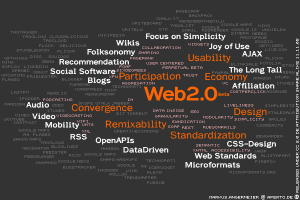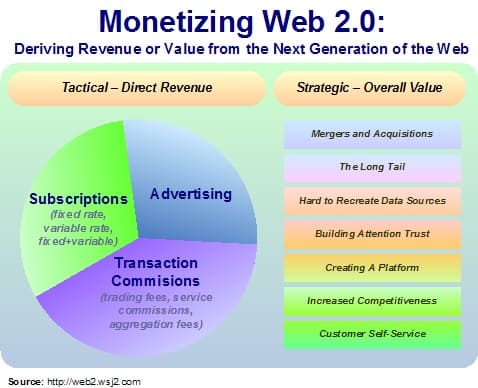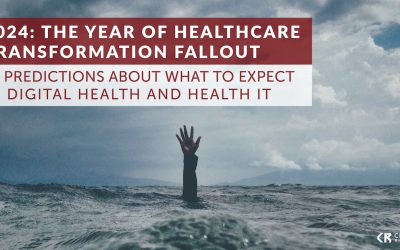
Based on this analysis, we are clearly at the very early stages of adoption as only 2.5% of hospitals nationwide are currently using Web2.0 to connect.
If one looks at the monetization figure below, clearly for hospitals, efforts are targeted at the strategic value of:
- Building Attention Trust (openness)
- Increasing Competitiveness (market visibility, consumer retention, affiliated physician retention) and,
- Customer Self-service (disease management, transactions, inquiries)





Fascinating post. There are so many players and turf battles vis-à-vis a Web presence for hospitals: anti-hacker focused IT guys versus medical librarians and marketing types who want a free flow on information and a strong Web presence for their institutions and entitles within in them and the sharp distinction in some places between medical records departments and medical libraries and other hospitals in which the two often share personnel.
John – hate to be the guy that dumps on web 2.0. I use Enterprise 2.0 technologies. So very familiar with these paradigms – and the utilities – see the value.
Did my speed-view/read on a few of these hospitals. Here is what I found – Twenty or so fans (thats streching it) and a few videos – which for the majority is content with no value. A quick view of the number of views is also telling. Yes good for the staff – and their self expression.
BUT – really – where is the “real” value with the presence on YouTube and Twitter. It goes back to what the hospitals have as content for viewing – and if they do – they do not need YouTube either.
Not beating on your post – but the original compilation itself. We are better as a society and individuals to be seduced by these Web 2.0 shenanigans – especially when it comes to our health.
Hope,
Thanks for the input from someone on the inside. How a medical practice adopts these solutions and who “runs the show” will evolve overtime as we are still very early in the adoption cycle. A lot of different entities will be vying for input, influence, and control. How that will all settle out will be partially depend on culture and partially on objectives. As it is still “early” have yet to see “best practices”. Even at conference I have attended, best practices presented to date are virtually meaningless.
And G,
Good comments/input. Do agree that today, the value of Web2.0 in the context of care is highly questionable, at least from a value delivered perspective. As I commented above, it is still very early in the adoption cycle and it is extremely difficult to ascertain what actually works.
And as for what actually works, well, that would depend on objectives. Is it marketing/visibility, is it community support for disease mgmt, is it simply educational/public service…?
The list goes on and on and from our early analysis, we are not convinced that enough consideration is given at the front-end in defining strategic objectives and metrics – thus do agree with you that much of what is out there is more of a sandbox for IT & marketing and not truly driven by an over-arching strategy.
Hospitals are likely to find Web 2.0 more valuable internally across the enteprise between physicians than public facing blogs for customers. A more open tool for posting observations and questions about clinical issues, exchanging case studies, and collaborating on treatment would be a big – no wait, a HUGE – step forward. Hospitals would be better served using the web 2.0 in this manner. Check out Sermo (www.sermo.com) or Jumper Networks (www.jumpernetworks.com) as great examples.
This post is based on my research, and is not supported by my data. My list simply shows the hospitals I know about that use YouTube, Facebook or Twitter. It is not a valid sample of all hospitals, and should not be used to make estimates of this type.
Thank you Ed for your input and comments. Yes, your data is drawn from a limited subset from sites you know and maybe we took liberties in extrapolating that data, but…
We believe that the numbers you did report are fairly accurate based on our own ltd work, thus the conclusions we reached in the post.
Please excuse our inadvertent/poor wording that may have some readers believing the conclusions came directly from you – it was completely OUR doing.
Hospitals as proactive embracer’s of change? I must be dreaming!
The traditional hospital is by definition insular and reactive. Typically a very defensive v open organism. Often referred to as “silos” or “cathedrals of the industrial/medical complex” (after all many of us have transferred our worship of religion to the institutional worship (“hope”) of what “high tech” medicine offers), hospitals are averse to innovation, and their special interest anti-change roots will have to be “broken” by powers greater than their addictive internal momentum.
Enter the Twitter revolution….all of a sudden, those firewalls and moats lose their power to control and capture the dance of reality behind those walls.
Some if not all of the “secrets” begin to get noticed, eg, adverse events, discontinuous care, stretched nurse staffing levels, the oft tenuous relationship between physicians, nurses and hospital administration, or perhaps a board of directors/trustees/governors in “la la land”, etc…
I say its time to turn on the light. Welcome to the “live web”.. and the accountability revolution this nervous system affords.
http://www.twitter.com/2healthguru